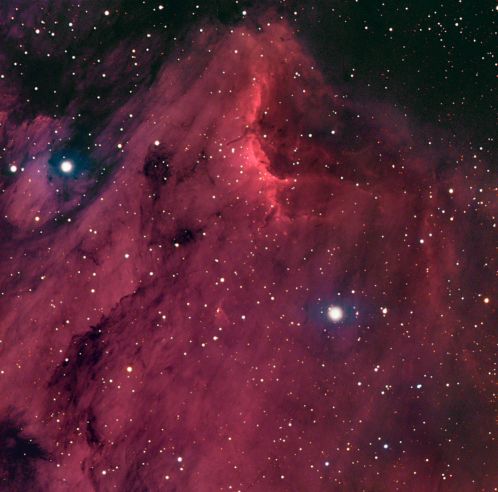Credit & Copyright: Robert Gendler
Explanation:
The Pelican Nebula, also known as IC 5070, lies about 2,000 light-years
away in the high and far-off
constellation of Cygnus, the Swan.
This picture spans a portion
of the magnificent nebula about 30 light-years wide.
Fittingly, this cosmic
pelican is found
just off the east "coast" of
the North America Nebula,
another surprisingly familiar looking
emission nebula in Cygnus.
In fact, the Pelican and North America nebulae are part of the same
large star forming region.
The two glowing
nebulae appear separated from our vantage point
by a large obscuring dust cloud running across the upper
left corner in this
gorgeous
color view.
Within the
Pelican
Nebula, dark dust clouds also help define
the eye and long bill, while a
bright front of ionized gas
suggests the curved shape of the head and neck.
Even though it is almost as close as the
Orion Nebula,
the stellar nursery marked by the Pelican and North America
nebulae has
proven complex and difficult to study.
1999 2000 2001 2002 2003 2004 2005 2006 2007 2008 2009 2010 2011 2012 2013 2014 2015 2016 2017 2018 2019 2020 2021 2022 2023 2024 2025 |
Январь Февраль Март Апрель Май Июнь Июль Август Сентябрь Октябрь Ноябрь Декабрь |
NASA Web Site Statements, Warnings, and Disclaimers
NASA Official: Jay Norris. Specific rights apply.
A service of: LHEA at NASA / GSFC
& Michigan Tech. U.
|
Публикации с ключевыми словами:
emission nebula - Pelican Nebula - Cygnus - star formation - эмиссионная туманность - Лебедь - звездообразование - Туманность Пеликан - IC 5070
Публикации со словами: emission nebula - Pelican Nebula - Cygnus - star formation - эмиссионная туманность - Лебедь - звездообразование - Туманность Пеликан - IC 5070 | |
См. также:
Все публикации на ту же тему >> | |
